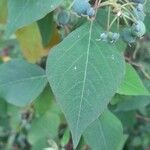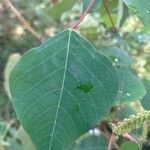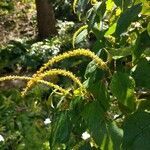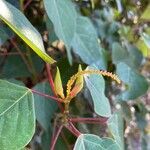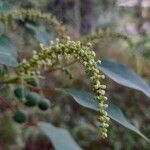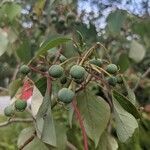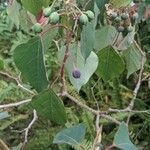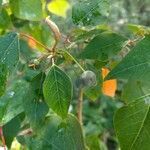A monoecious completely glabrous shrub or small tree 2–3.5 m. tall.. Young shoots and petioles reddish.. Petioles (1–)3–9 cm. long, slender; petiolar glands small, sessile or subsessile; leaf-blades ovate-rhombate to ovate-deltate, 4–14 cm. long, 2–10 cm. wide, acutely acuminate, cuneate to subtruncate, entire, firmly membranaceous to thinly chartaceous, lateral nerves 15–18 pairs, the distal ones small and indistinct, not prominent above, somewhat prominent beneath, tertiary nerves subparallel, medium green above, glaucous beneath.. Stipules narrowly lanceolate, 1–1.8 cm. long, acute, entire, cordulate-auriculate, scarious, yellowish brown, leaving prominent scars.. Inflorescences 6–12 cm. long, with (1–)3–6(–9) ♀ flowers at the base; bracts broadly ovate to transversely ovate, 1 mm. long, 1.5 mm. wide, rounded, sparingly denticulate, 3–6-flowered, basal glands discoid.. Male flowers: pedicels 1.5–2 mm. long, articulate near the base; sepals 2, reniform-soleiform, 1 mm. long and wide, rounded, shallowly denticulate to subentire, yellowish green or greenish white; sta-mens 8, anthers 4-lobed, 0.6–0.7 mm. diameter, the lobes minutely papillulose, bright golden-yellow.. Female flowers: pedicels 5 mm. long, extending to 2–3.5 cm. long in fruit; calyx-lobes 2, transversely ovate, 1 mm. long, 1.5–2 mm. wide, rounded, minutely denticulate, greenish white; ovary 2-locular, ovoid-ellipsoid, 1 mm. long, 0.8 mm. diameter, smooth; styles 2, 3–4 mm. long, subpersistent, the arms each with a small abaxial gland near the apex.. Fruit bilobate, 8–9 mm. long and wide, ± smooth, dull green or grey-green. Columella 6–7 mm. long, flat.. Seeds 5 mm. long, 3 mm. wide, ± smooth.
More
Glabrous shrub or small tree up to 5 m high. Twigs rounded, slightly ribbed. Lvs ovate to rhombic, truncate to obtuse at base, acute to acuminate or rarely obtuse at apex, (3)-5-15-(20) cm long, usually turning red in cooler part of year; seedling lvs broadly ovate, truncate at base; petioles >, =, or < blade; stipules soon deciduous. Racemes up to 17 cm long, usually with few solitary long-pedicellate ♀ fls below or at base, and many clusters of (1)-3-4 short-pedicellate ♂ fls (racemes rarely unisexual, or with 1-2 ♂ fls clustered with upper ♀); each group of fls subtended by a bract and 2 prominent glands. ♂ fls: stamens 4-10; perianth segments 2. ♀ fls: ovary 2-celled; styles 2. Fr. ± smooth, grooved between the 2 cells, ridged on keels, glaucous, 8-10 mm diam.
Lowland and lower montane forest regrowth, secondary forest, well drained or swamp forest, on ridges, riversides, from sea level up to elevations of 1,000 metres.

